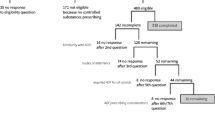Abstract
The U.S. Food and Drug Administration has authorized many narcotic (i.e., opioid) painkillers for the treatment of mild to moderately severe acute or chronic pain in humans. In recent years, there has been a sharp increase in the number of individuals who fake symptoms in order to get prescriptions for these opiates for recreational use. The purpose of this study is to develop a multi-branched system that would aid physicians in identifying and eliminating such deceptive patients. The first branch attempts to determine whether patients are faking their symptoms, while the second branch utilizes the EHR to predict how much of the prescription opioid the patient requires. This will eventually prevent patients from becoming dependent on these medications and preserve these pharmaceuticals for their intended use.
Access this chapter
Tax calculation will be finalised at checkout
Purchases are for personal use only
Similar content being viewed by others
References
Wu QX, Bell DA, McGinnity TM, Prasad G, Qi G, Huang X (2006) Improvement of decision accuracy using discretization of continuous attributes. Springer, Berlin. https://doi.org/10.1007/11881599_81
Veitch DP et al (2019) Understanding disease progression and improving Alzheimer's disease clinical trials: recent highlights from the Alzheimer's disease neuroimaging initiative. Alzheimer's & Demen 15(1):106–152
Choi E et al (2016) Doctor AI: predicting clinical events via recurrent neural networks. In: Machine learning for healthcare conference. PMLR
Solares JRA et al (2020) Deep learning for electronic health records: a comparative review of multiple deep neural architectures. J Biomed Inform 101:103337
Meyer R, Patel Anisha M, Rattana SK, Quock TP and, Mody SH (2014) Prescription opioid abuse: a literature review of the clinical and economic burden in the United States. Popul Health Manage. https://doi.org/10.1089/pop.2013.009
Jing X (2012) A Bayesian network based intelligent plant classification system. Fourth Int Symp Inform Sci Eng 2012:263–265. https://doi.org/10.1109/ISISE.2012.65
Roveri M (2019) Learning discrete-time markov chains under concept drift. IEEE Trans Neural Netw Learn Syst 30(9):2570–2582. https://doi.org/10.1109/TNNLS.2018.2886956
Mbarki A, Naouai M (2020) A marked point process model for visual perceptual groups extraction. IEEE Int Conf Vis Commun Image Proces (VCIP) 2020:511–514. https://doi.org/10.1109/VCIP49819.2020.9301776
Van Houdt G, Mosquera C, Nápoles G (2020) A review on the long short-term memory model. Artif Intell Rev 53(8):5929–5955
Chung J, Gulcehre C, Hyun Cho K, Bengio Y (2014) Empirical evaluation of gated recurrent neural networks on sequence modeling. In: NIPS 2014 deep learning and representation learning workshop, https://arxiv.org/abs/1412.3555
Che Z, Sauver JS, Liu H, Liu Y (2017) Deep learning solutions for classifying patients on opioid use. AMIA Annu Symp Proc. 16 Apr 2018
Compton WM, Han B, Blanco C, Crane E, Lee J, Jones CM (2017) Prescription opioid use, misuse, and use disorders in US adults: 2015 national survey on drug use and health. Ann Intern Med 167(5):293–301
Hudgins JD, Porter JJ, Monuteaux MC, Bourgeois FT (2019) Prescription opioid use and misuse among adolescents and young adults in the United States: a national survey study. PLoS Med 16(11):e1002922. https://doi.org/10.1371/journal.pmed.1002922
Cicero TJ, Ellis MS, The prescription opioid epidemic: a review of qualitative studies on the progression from initial use to abuse. Dialog Clin Neurosci 19(3):259–269. https://doi.org/10.31887/DCNS.2017.19.3/tcicero
Dong X, Rashidian S, Wang Y, Hajagos J, Zhao X, Rosenthal RN, Kong J, Saltz M, Saltz J, Wang F (2019) Machine learning based opioid overdose prediction using electronic health records. In: AMIA annual symposium proceedings, pp 389–398. 4 Mar 2020. PMID: 32308832; PMCID: PMC7153049
Vunikili R et al (2021) Predictive modelling of susceptibility to substance abuse, mortality and drug-drug interactions in opioid patients. Front Artif Intel 4:742723. 10 Dec 2021. https://doi.org/10.3389/frai.2021.742723
Cowie MR, Blomster JI, Curtis LH et al (2017) Electronic health records to facilitate clinical research. Clin Res Cardiol 106:1–9. https://doi.org/10.1007/s00392-016-1025-6
Hamdan YB (2020) Faultless decision making for false information in online: a systematic approach. J Soft Comput Paradig (JSCP) 2(4):226–235
Sungheetha A (2021) COVID-19 risk minimization decision making strategy using data-driven model. J Inf Technol 3(1):57–66
Author information
Authors and Affiliations
Corresponding author
Editor information
Editors and Affiliations
Rights and permissions
Copyright information
© 2023 The Author(s), under exclusive license to Springer Nature Singapore Pte Ltd.
About this paper
Cite this paper
Deolekar, R.V., Wankhade, S., Wanve, M. (2023). Decision Support System for Weeding Out Drug Seeking Behavior from Emergency Clinics. In: Smys, S., Kamel, K.A., Palanisamy, R. (eds) Inventive Computation and Information Technologies. Lecture Notes in Networks and Systems, vol 563. Springer, Singapore. https://doi.org/10.1007/978-981-19-7402-1_17
Download citation
DOI: https://doi.org/10.1007/978-981-19-7402-1_17
Published:
Publisher Name: Springer, Singapore
Print ISBN: 978-981-19-7401-4
Online ISBN: 978-981-19-7402-1
eBook Packages: EngineeringEngineering (R0)




